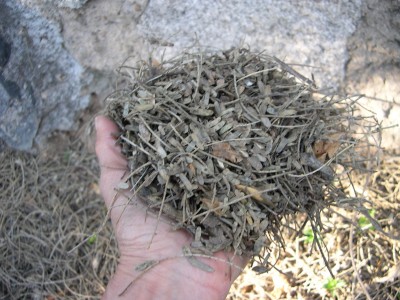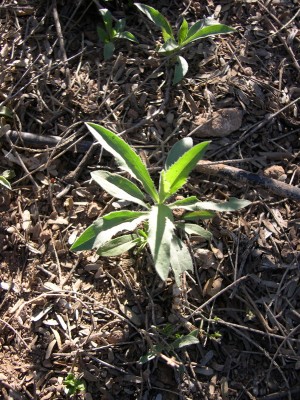No-Effort, No-Cost Water Harvesting
By Julia Fonseca
Whew, digging swales and basins is hard work! Gutters and tanks are expensive. And as the skimpy summer rains of 2009 demonstrated, how do you harvest rain when the rain refuses to fall?
Fortunately, there is a way to harvest water, even during droughts. It costs nothing, and requires no expenditure of energy. Can this be true? Grab yourself a cool drink, take a seat, and let the litter fall. Leaf and stem litter, that is.

You’ve been spending too much time raking and bagging those leaves, seed pods and twigs. They could be working for you, if you don’t throw them out. No, I’m not talking about composting. Composting is work too! But if you just left the litter where it fell, it would in time form a nice natural mulch that would slow erosion, build up the water-holding ability of the soil, and help make the soil easier to dig, if you do decide to dig a swale someday. Be a litter harvester!
Plant litter is so important that it is one of the three key measurements that the Natural Resources Conservation Service uses as a measure of watershed condition. Plant cover, litter, and rock all help stem erosion of sloping land. If it’s not raining, only litter and rock can retard runoff, and shade the soil, AND retain moisture. (But see my rant against crushed rock landscaping.)
A layer of litter will work for you every time it rains well enough to penetrate the litter layer, making it more difficult for the sun to evaporate moisture from the soil below. So, if you do need to rake up litter, then consider moving it to areas where it can mulch a plant.
Even when it isn’t raining, a layer of leaf litter recruits workers to improve your soil. Unlike rock, leaf and twig litter is readily colonized by tiny organisms, and those attract others and pretty soon you have unpaid laborers tunneling into your soil, creating “macropores” for better, deeper infiltration. In urban Tucson you can also get thrashers, cactus wrens and towhees tilling the ground and scratching for goodies!
All work together to decompose your litter into smaller pieces, and that helps pump extra carbon into the soil. Extra carbon in your soils is part of the magic. Soil carbon boosts the ability of the soil to hold water for later use by plants, resulting in a healthier and more drought-resistant landscape.

